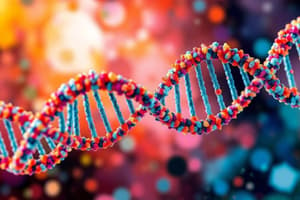Podcast
Questions and Answers
What do restriction endonucleases do in a bacteria's restriction system?
What do restriction endonucleases do in a bacteria's restriction system?
- Produce numerous identical copies of the gene
- Reduce the efficiency of plating
- Transport the gene into a host cell
- Destroy the incoming DNA if it is recognized as foreign (correct)
What is the purpose of a vector in gene cloning?
What is the purpose of a vector in gene cloning?
- To destroy the gene to be cloned
- To recognize specific sequences in the incoming DNA
- To reduce the efficiency of plating
- To transport the gene into a host cell (correct)
What is the result of restriction endonucleases cleaving the incoming DNA?
What is the result of restriction endonucleases cleaving the incoming DNA?
- Reduction in vector replication
- Random synthesis of DNA fragments (correct)
- The destruction of the vector
- Production of numerous identical gene copies
What happens when the host cell divides after vector replication?
What happens when the host cell divides after vector replication?
Flashcards are hidden until you start studying
Study Notes
Restriction System in Bacteria
- Restriction endonucleases defend bacteria against foreign DNA by cutting it into smaller pieces, preventing its replication.
Gene Cloning
- A vector is a small, self-replicating DNA molecule that carries a foreign gene into a host cell, allowing it to replicate and express the gene.
- The purpose of a vector is to act as a carrier of the foreign gene, enabling its introduction and expression in a host cell.
Restriction Endonucleases' Action
- Restriction endonucleases cleave the incoming DNA at specific recognition sites, producing fragments with sticky ends.
Vector Replication and Host Cell Division
- After vector replication, the host cell divides, and the vector is passed to daughter cells, ensuring the continued presence of the foreign gene.
Studying That Suits You
Use AI to generate personalized quizzes and flashcards to suit your learning preferences.




